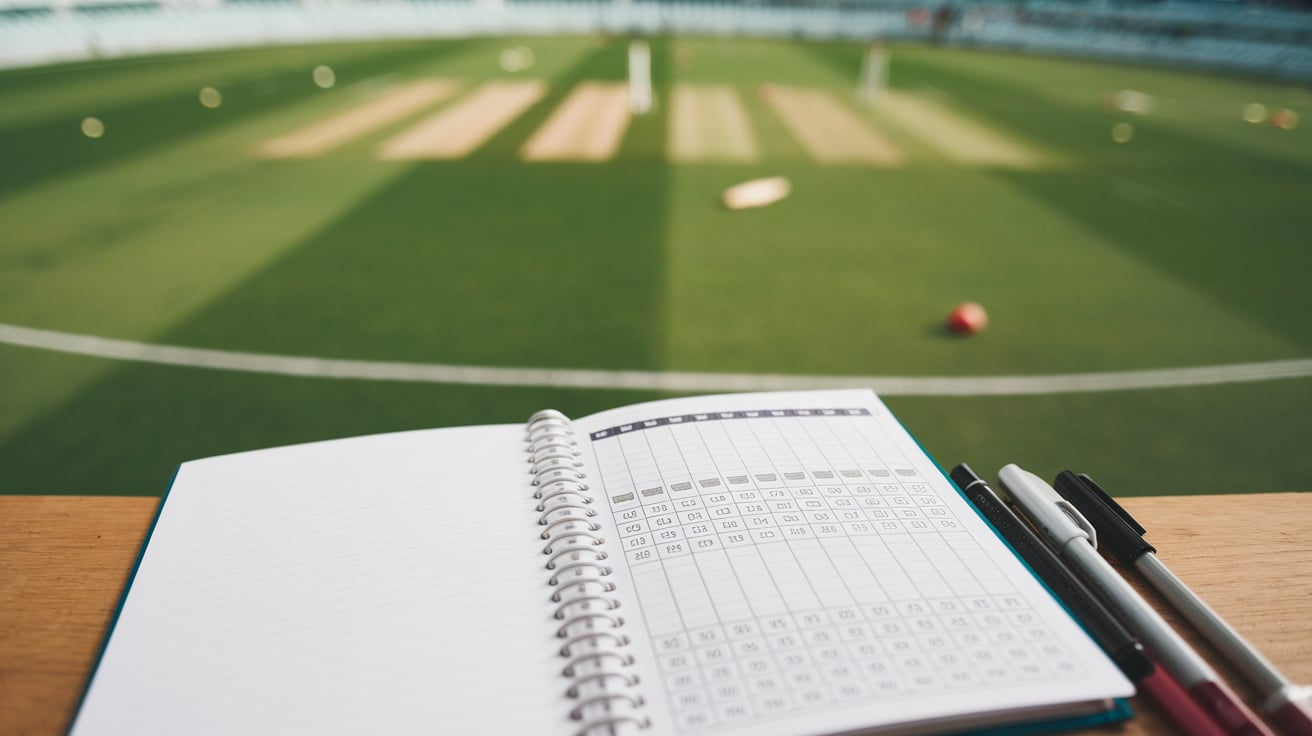A cricket score book is an important tool for tracking every moment of a cricket match. Whether you’re playing in the park with friends or organizing a local tournament, having a cricket score book ensures that you don’t miss any crucial details. It helps record the runs, wickets, and individual player stats, giving you a full picture of the match. Without a proper scorebook, it can be tough to keep track of who’s doing well and where the game stands. A cricket score book is much more than just a place to write numbers; it’s a record of the game’s story, helping you look back on the match later and analyze the performance.
In addition to being practical, a cricket score book is an essential part of cricket culture. It’s a tradition that goes hand in hand with the game. Many professional and amateur players alike swear by the benefits of using a score book. It’s not just about numbers; it’s about telling the story of the match, tracking the performances, and keeping the spirit of the game alive. A cricket score book is also helpful for players who are looking to improve their skills, as it provides a clear record of how each player performed. By analyzing stats like batting averages, bowling economy rates, and partnerships, players can find ways to improve their game and plan better strategies for future matches.
How to Use a Cricket Score Book for Tracking Match Stats
A cricket score book helps you track all the key statistics of a match, including runs, wickets, and overs. Start by noting the teams and the format of the game at the beginning. For each player’s batting, record the number of balls faced, runs scored, and the type of dismissal. Similarly, for bowlers, write down the number of overs bowled, runs conceded, and wickets taken. Keeping track of extras like no-balls, wides, and byes is also essential. You can use simple marks or symbols to indicate boundaries, sixes, and other special achievements. This method allows you to review the match’s progress and see individual performances. By following this simple approach, you ensure that no important details are missed, and it becomes easy to analyze the match later.
The Importance of Keeping a Cricket Score Book for Local Matches
For local cricket matches, a score book plays a significant role in organizing the game and ensuring fairness. In informal settings like gully cricket or neighborhood tournaments, players often forget details like the number of overs or who scored the most runs. A cricket score book helps prevent these mistakes by keeping track of every detail. It also helps in resolving any disputes about the game, especially when questions arise about who won or what the exact score was. By recording stats like batting averages or strike rates, a score book offers a complete summary of the match. It also makes it easier for players to see where improvements can be made in future games, enhancing both individual and team performances.
Top Features Every Cricket Score Book Should Have
A good cricket score book should have several key features to ensure effective tracking of the match. First, it should provide enough space for writing player names and detailed statistics such as runs, wickets, and overs. It should also allow for easy recording of extras like wides, no-balls, and byes. A well-organized layout will help users quickly note down the scores without confusion. Some scorebooks also include areas to track individual performances like batting and bowling averages, which can be useful for players looking to improve. Additionally, a cricket score book should have a durable cover and pages that can withstand frequent use. With these features, you’ll have a practical tool that makes match tracking smooth and enjoyable.
Why Cricket Score Books Are a Must-Have for Cricket Coaches
For cricket coaches, score books are essential tools for analyzing player performance and planning future strategies. Coaches can use score books to keep track of batting order, bowling rotations, and performance trends over time. A score book provides a clear record of how players performed in different situations, which helps coaches assess strengths and weaknesses. With this data, they can create personalized improvement plans for each player. Furthermore, coaches can use the scorebook to compare different match situations, such as chasing a target versus setting one. It allows coaches to teach players how to manage pressure, plan innings, and work as a team. Overall, a cricket score book is indispensable for effective coaching.
Best Cricket Score Books Available in the Market
When selecting a cricket score book, it’s important to consider factors like size, durability, and ease of use. Some of the best options in the market include products from trusted brands like Gray-Nicolls, Kookaburra, and Slazenger. These scorebooks come with clear layouts, high-quality paper, and features that make tracking stats easy. Some models offer special pages for keeping track of player averages, while others include extra space for match notes and comments. If you’re looking for something more advanced, digital cricket scorebooks are also available, providing automatic calculations and real-time updates. Whether you’re looking for a traditional paper scorebook or a modern digital version, choosing the right one will ensure that you never miss an important detail during the game.
How a Cricket Score Book Helps Players Improve Their Game
A cricket score book is not just a tool for recording match stats; it’s also a valuable resource for player development. By keeping track of individual performances, players can see where they excel and where they need improvement. For example, batsmen can review their run rates, the number of balls faced, and how many boundaries they hit. Similarly, bowlers can analyze their economy rate, wickets taken, and number of overs bowled. These insights are crucial for making adjustments in practice and future matches. Players can also track how they perform in different game situations, helping them to better understand their strengths under pressure. Overall, a cricket score book helps players focus on their personal growth and maximize their potential.
Tips for Organizing Your Cricket Score Book for Better Match Tracking
Organizing your cricket score book is key to making match tracking as easy and effective as possible. Start by creating a simple layout for each match, with sections for team names, match format, and player details. Always use the same format for consistency, making it easier to follow in future matches. Divide each player’s statistics into clear categories such as runs, balls faced, wickets, and overs bowled. Make sure there’s enough space for extras like wides, no-balls, and byes, as well as additional notes on player performance. After the match, review the scorebook and make any additional notes or observations, which will be helpful for later analysis. Keeping the scorebook neat and well-organized ensures that you don’t waste time searching for important data during a match.
The Evolution of Cricket Score Books: From Paper to Digital
Cricket score books have evolved significantly over the years. Traditionally, scorebooks were made of paper and required manual calculations to keep track of the match. This process was time-consuming and could often lead to errors. However, with advancements in technology, digital scorebooks have emerged, offering more convenience and accuracy. Today, digital cricket scorebooks can calculate runs, wickets, and other stats in real-time, providing instant feedback. These apps can also store historical data, allowing players and coaches to track progress over multiple matches. While traditional paper scorebooks are still popular for their simplicity and nostalgic appeal, digital versions offer a modern solution for those looking for a more automated experience. This evolution continues to improve the way cricket matches are tracked and analyzed.
Understanding Key Stats in a Cricket Score Book: A Beginner’s Guide
If you’re new to using a cricket score book, understanding the key stats is essential. Some of the most important stats include runs, balls faced, wickets, overs bowled, and extras like wides and no-balls. As a beginner, focus on recording these basics first. For batsmen, you should write down how many runs they score and how many balls they face, as this will help calculate their strike rate. For bowlers, track the number of overs they bowl, the runs they give away, and the wickets they take. Once you become more familiar with the process, you can begin to track advanced stats like batting average, bowling economy, and partnership runs. Understanding these stats will help you analyze and improve your game over time.
How to Choose the Right Cricket Score Book for Your Team
Choosing the right cricket score book for your team is an important decision. First, consider the level of detail you need. For amateur or local matches, a simple score book that tracks runs and wickets may be enough. However, for more advanced analysis, look for a scorebook that includes spaces for individual player statistics, averages, and other key data. Durability is also a factor to consider, especially if you plan to use the scorebook frequently. You’ll want a book with sturdy pages and a durable cover to withstand wear and tear. Additionally, consider the size of the scorebook—one that’s easy to carry but offers enough space for recording all the necessary stats. The right score book will help your team track performance and improve over time.
Conclusion
In conclusion, using a cricket score book is an essential tool for anyone who loves the game of cricket. Whether you’re a player, coach, or a fan, keeping track of stats and performances can help you improve your skills and understand the game better. A good score book not only helps you follow the match but also gives you a chance to analyze players’ strengths and weaknesses. So, always keep your score book handy and make it a part of every match you play or watch.
By staying organized and recording all the important details, you can create a helpful history of each game. This information can be used to track improvements over time and make smarter decisions for future matches. A cricket score book is more than just a notebook – it’s a great tool to grow your love for cricket while sharpening your skills. So, next time you’re on the field, make sure to have your score book ready!
FAQs
Q: What is a cricket score book?
A: A cricket score book is used to record important statistics during a cricket match, such as runs, wickets, overs bowled, and extras like wides and no-balls.
Q: Can I use a digital score book instead of a paper one?
A: Yes, you can use a digital cricket scorebook, which automatically calculates stats like runs, wickets, and overs, making it easier and faster to track the game.
Q: How do I organize a cricket score book?
A: To organize a score book, divide the pages into sections for each team, and for each player, record runs, balls, wickets, and other stats like extras.
Q: Can I track both batting and bowling stats in the same scorebook?
A: Yes, most cricket score books allow you to track both batting and bowling stats in separate sections, so you can keep an eye on every player’s performance.
Q: Do cricket score books come in different sizes?
A: Yes, cricket score books come in various sizes, from small pocket-sized versions to larger ones with more space for detailed records.

